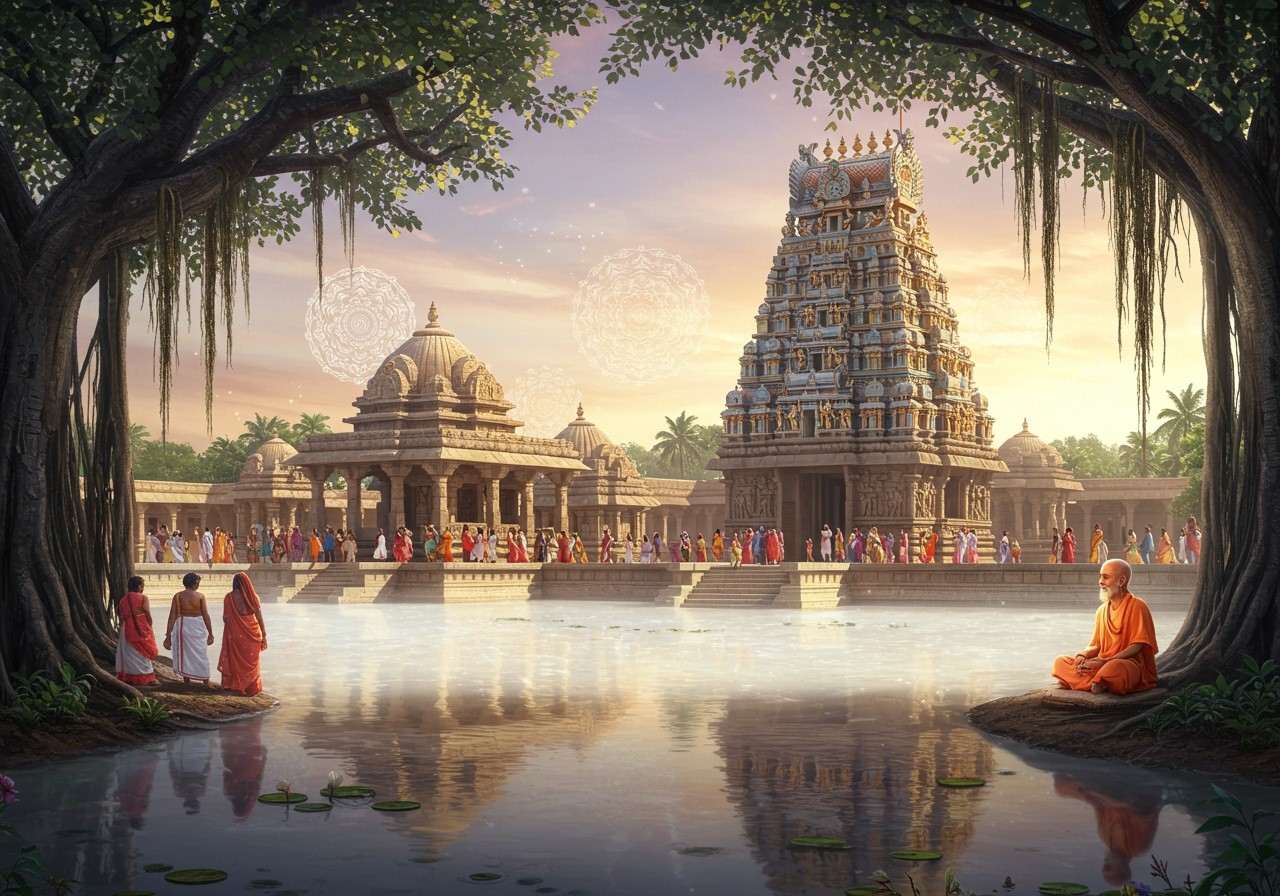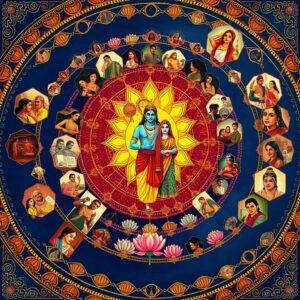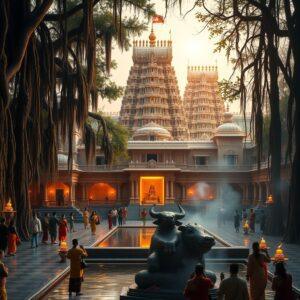
Ksheerarama Temple, nestled in Palakollu, Andhra Pradesh, is a revered sanctuary dedicated to Lord Shiva. As one of the esteemed Pancharama Kshetras, it holds profound significance in Hindu mythology and spirituality. This article explores the temple’s rich heritage, unique rituals, architectural marvels, and its impact on the cultural landscape. For those seeking to explore Hinduism further, Poojn.in offers a wealth of resources on core beliefs and practices, Hindu Gods and Goddesses, Hindu temples, Hindu rituals, and sacred texts.
Origins and Historical Background
Uncovering the Historical Significance
The Ksheerarama Temple’s history traces back to the 9th century AD, constructed under the patronage of the Eastern Chalukyas, with King Chalukya Bhima playing a pivotal role. As one of the five Pancharama Kshetras, each dedicated to Lord Shiva, its significance is deeply rooted in Hindu scriptures and mythology. The temple’s development has been shaped by the influence of various dynasties, including the Cholas and the Vijayanagara Empire. Historical accounts and inscriptions within the temple’s walls offer invaluable insights into its evolution. Centuries of meticulous restoration efforts have ensured the preservation of its architectural and spiritual legacy.
Architectural Marvel
Exploring the Dravidian Splendor
Ksheerarama Temple stands as a testament to the magnificence of Dravidian architecture, characterized by towering gopurams (entrance towers) and intricate carvings. The temple’s layout encompasses the main sanctum (Garbhagriha), mandapas (pillared halls), and the vimana (tower above the sanctum). The temple’s iconography and sculptures depict a rich tapestry of deities, mythological narratives, and floral motifs. The five-storied Rajagopuram commands attention, while the white Shiva Lingam (Ksheera Linga) within the sanctum lends the temple its name. Stone inscriptions offer glimpses into the temple’s historical and cultural context. The artistic excellence of the mandapa pillars is particularly noteworthy.
Rituals and Festivals
Understanding the Sacred Practices
Daily rituals at Ksheerarama Temple include the sacred abhishekam (ritualistic bathing), alankaram (decoration), and aarti (ceremonial worship with light). Major festivals such as Maha Shivaratri, Karthika Masam, and Navaratri attract devotees from across the nation. The annual Rathotsavam (chariot festival) is a grand spectacle, featuring a procession of the deity. Special poojas and homams are performed for blessings of health, prosperity, and spiritual growth. The temple adheres to unique traditions and customs during these auspicious occasions, with temple priests diligently maintaining the sanctity of the rituals. Visitors can consult the temple timings to witness these sacred practices firsthand.
Cultural and Spiritual Significance
Embracing the Essence
Ksheerarama Temple serves as a beacon of devotion for Lord Shiva’s followers, preserving ancient traditions while promoting cultural heritage. It plays a vital role in the local community through social and charitable activities. The temple’s festivals feature classical music and dance performances, attracting art enthusiasts. Ksheerarama fosters unity among devotees, creating a shared sense of spirituality. Local legends and folklore surrounding the temple enhance its mystical allure, and devotees often share profound spiritual experiences that strengthen their faith.
Visitor Information and Practical Tips
Planning Your Visit
Reaching Ksheerarama Temple is convenient, with flights available to Vijayawada Airport and train services to Palakollu Railway Station. Well-connected road routes cater to those traveling by car or bus. Accommodation options range from budget-friendly to luxurious. The ideal time to visit is during major festivals, when the temple is vibrant with celebrations. First-time visitors are advised to dress modestly and respect local customs. Photography guidelines should be observed. Consider engaging a local guide for a deeper understanding of the temple’s history. Nearby attractions in Palakollu offer additional cultural experiences. Contact the temple administration for any special arrangements or queries.
FAQs about Ksheerarama Temple – Divine Significance and History
What is the history of Ksheerarama Temple?
Ksheerarama Temple, situated in Palakollu, Andhra Pradesh, is one of the five Pancharama Kshetras dedicated to Lord Shiva. Its history goes back to the 9th century AD, with strong ties to the Chalukya dynasty and their patronage of the temple’s construction.
Why is Ksheerarama Temple significant?
The temple’s significance lies in its status as one of the Pancharama Kshetras, where Lord Shiva is believed to manifest as a Shivalinga. Devotees believe that visiting this sacred site can absolve sins and bestow moksha (liberation).
What are the main attractions in Ksheerarama Temple?
Key attractions include the towering Shiva Lingam, the exquisite Dravidian architecture, intricate wall carvings, the large Nandi statue, and the unique white Shiva Lingam.
Are there any specific rituals performed at Ksheerarama Temple?
Yes, daily rituals encompass Abhishekam, Alankaram, and Aarti. Special poojas are conducted during festivals like Maha Shivaratri, drawing numerous devotees.
Can I find Ksheerarama photos online?
Yes, numerous photos showcasing the temple’s architecture, rituals, and festivals are readily available online.
What are the reviews for Ksheerarama Temple?
Visitors consistently give positive reviews, praising the serene atmosphere, historical significance, and architectural beauty.
What is the best time to visit Ksheerarama Temple?
The winter months (October to February) offer pleasant weather for a visit. Experiencing the vibrant atmosphere during festivals like Maha Shivaratri is also recommended.
Is there any dress code for visiting Ksheerarama Temple?
Modest attire is expected. Men traditionally wear dhotis, while women wear sarees or salwar kameez.
Enhance Your Spiritual Journey with Poojn.in
Poojn.in, India’s leading provider of spiritual and puja items, invites you to deepen your connection with the divine. We offer a curated selection of products to enhance your home worship and create a sacred space reminiscent of Ksheerarama Temple.
- Brass Deities: Bring the divine presence into your home with our exquisite brass deities, including Lord Shiva. Explore our collection of Lord Shiva murtis here. Our meticulously crafted murtis serve as a focal point for devotion and meditation, allowing you to connect with Lord Shiva’s energy on a deeper level. They are available in various sizes and styles to suit your preferences and home shrine.
- Puja Items: Perform authentic pujas with our complete range of puja samagri, including incense, diyas, and offerings. Discover our high-quality camphor for your puja rituals. We offer a wide selection of camphor, incense sticks, diyas (oil lamps), and other essential items to enhance the authenticity and spiritual significance of your home worship.
Visit www.poojn.in today to explore our complete collection and embark on a journey of spiritual enrichment.


